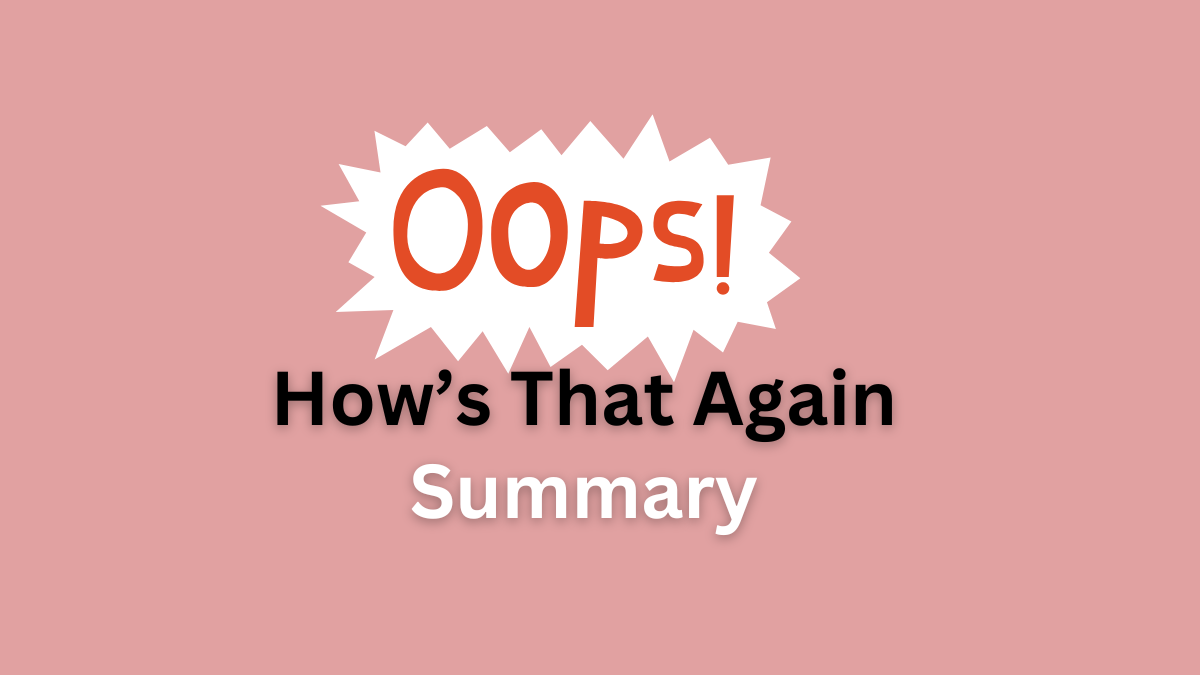Oops! How’s That Again? Summary
“Oops! How’s That Again?” by Roger Rosenblatt is an entertaining essay that delves into the humorous yet revealing world of verbal mistakes. These errors, ranging from minor slips to more significant blunders, are a part of everyday human interaction.
Rosenblatt categorizes these mistakes into four types: public blunders, memorable mistranslations, bloopers, and spoonerisms, each shedding light on the complexities of human communication.
Public Blunders are the kind of errors often made during speeches, especially by political figures. These speakers might neglect grammatical correctness or choose the wrong words, leading to unintended messages.
For example, Nancy Reagan once referred to voters as “The beautiful white people,” a statement that could be seen as excluding non-white voters. Such mistakes occur due to slips of the tongue and can have varying interpretations among audiences.
Memorable Mistranslations happen when someone speaks too quickly or translates phrases poorly. These mistakes often lead to misunderstandings between the speaker and listener.
A classic example is Pepsi’s slogan “Come alive with Pepsi,” which was humorously mistranslated into German as “Come alive out of the grave with Pepsi.” Such errors highlight the importance of context and clarity in communication.
Bloopers are foolish mistakes that the speaker might not even notice or bother to correct. These simple errors, often occurring in casual settings like TV and radio shows, can be quite amusing.
An example is mistakenly referring to Herbert Hoover as “Boobert Heever.” Bloopers are usually seen as minor slip-ups that don’t significantly impact the message.
Spoonerisms involve the accidental swapping of sounds within words, creating funny and often confusing statements. Named after William Archibald Spooner, these errors can lead to amusing misunderstandings.
For instance, Spooner once said, “You hissed all my mystery lectures” instead of “You missed all my history lectures.” Such mistakes are quickly corrected by the speaker but can still create a moment of confusion and laughter.
Rosenblatt also explores the psychological reasons behind these verbal errors. According to linguist Victoria Fromkin, these mistakes show how the brain processes language.
Sigmund Freud, the famous psychiatrist, believed that slips of the tongue reveal hidden desires and thoughts. Philosopher Henri Bergson suggested that we laugh at these mistakes because they disrupt the normal flow of conversation, much like slipping on a banana peel.
Read More: Summary of Concrete Cat
Overall, “Oops! How’s That Again?” highlights that making mistakes while speaking is a natural part of being human. These errors, whether made by a regular person or a highly educated individual, are universal.
Despite their humorous nature, verbal mistakes provide insight into how our brains work and how we communicate. Rosenblatt’s essay, filled with entertaining examples and thoughtful analysis, reminds us that no one is perfect and that our verbal slip-ups are just another aspect of our shared human experience.
Read More: Summary of Unchopping a Tree
Important Questions and Answers
Into what categories does Rosenblatt organize verbal mistakes?
Rosenblatt categorizes verbal mistakes into four types: public blunders, memorable mistranslations, bloopers, and spoonerisms.
What are public blunders, and who often makes them?
Public blunders are mistakes made during speeches, often by political figures. These errors can include grammatical mistakes or poorly chosen words that lead to unintended messages.
What is an example of a memorable mistranslation mentioned in the essay?
A memorable mistranslation mentioned in the essay is Pepsi’s slogan “Come alive with Pepsi,” which was mistranslated into German as “Come alive out of the grave with Pepsi.”
What are bloopers, and how are they typically perceived?
Bloopers are foolish mistakes that speakers might not notice or correct. They often occur in casual settings like TV and radio shows and are generally seen as amusing and minor slip-ups.
How do linguists and psychologists explain verbal mistakes?
Linguist Victoria Fromkin suggests that verbal mistakes reveal how the brain processes language. Sigmund Freud believed these slips show hidden desires and thoughts. Philosopher Henri Bergson thought we laugh at these mistakes because they interrupt the normal flow of conversation.
Read Next: Summary of The Nightmare Life Without Fuel
